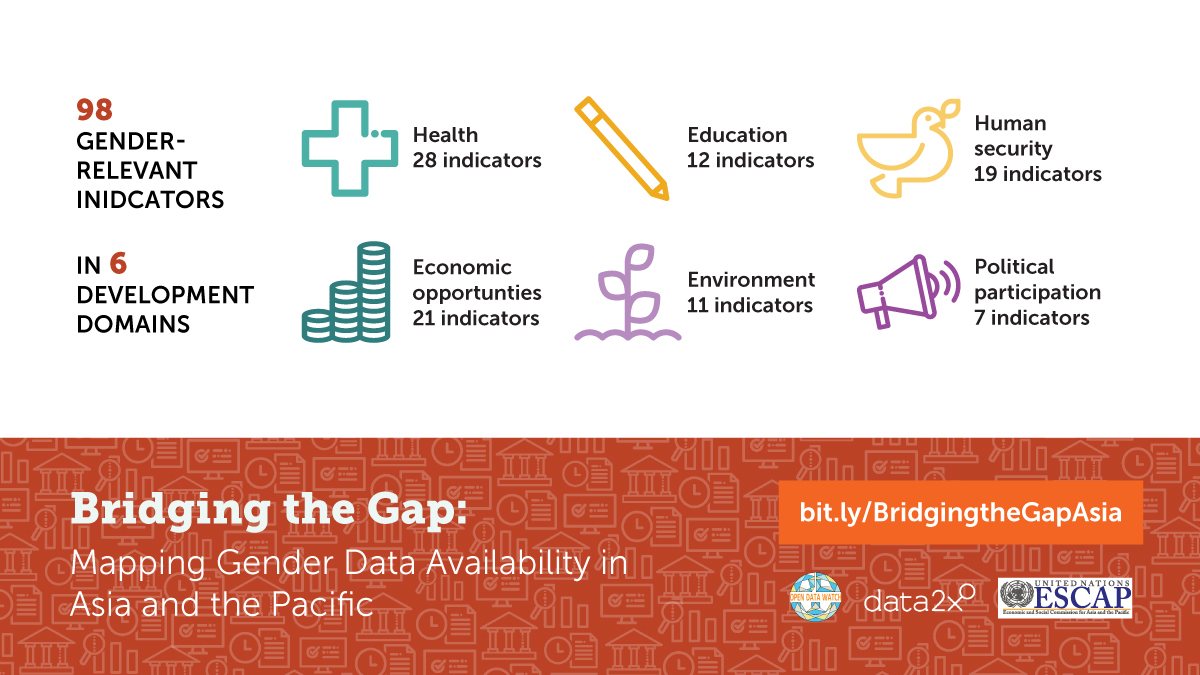In collaboration with @Data2x and @UNESCAP, we are excited to announce the release of Bridging the Gap: Mapping #GenderData Availability in Asia and the Pacific, which assesses gaps across 5 countries in 6 domains. Check out the major takeaways!  https://abs.twimg.com/emoji/v2/... draggable="false" alt="🧵" title="Thread" aria-label="Emoji: Thread">:
https://abs.twimg.com/emoji/v2/... draggable="false" alt="🧵" title="Thread" aria-label="Emoji: Thread">:
1. Around half of gender-relevant indicators lack sex-disaggregated data or are missing entirely. This is slightly less (46%) in national databases and slightly more (53%) in international databases.
2. The #health domain has the highest number of sex-disaggregated indicators at both the national and international levels.
3. The #environment domain had the least, with two indicators out of 11 sex-disaggregated at the international level and only one country, the Philippines, reporting any sex-disaggregated indicators in its national database.
4. The shortage of #GenderData limits our knowledge of the status and well-being of women and girls in countries around the world.
5. How can we encourage a virtuous cycle between #GenderData production and use? One idea https://abs.twimg.com/emoji/v2/... draggable="false" alt="💡" title="Elektrische Glühbirne" aria-label="Emoji: Elektrische Glühbirne">is to connect #GenderEquality objectives in national strategies to measurable indicators.
https://abs.twimg.com/emoji/v2/... draggable="false" alt="💡" title="Elektrische Glühbirne" aria-label="Emoji: Elektrische Glühbirne">is to connect #GenderEquality objectives in national strategies to measurable indicators.
For more findings, read the Technical Report here: https://bit.ly/3u24Kb5 ">https://bit.ly/3u24Kb5&q...
For more context on data and gender policies, read the Policy Reports here: http://bit.ly/BridgingtheGapAsia">https://bit.ly/Bridgingt...
For additional information on the methodology, read the Methodology Report here: https://bit.ly/3eBNWkR ">https://bit.ly/3eBNWkR&q...

 Read on Twitter
Read on Twitter :" title="In collaboration with @Data2x and @UNESCAP, we are excited to announce the release of Bridging the Gap: Mapping #GenderData Availability in Asia and the Pacific, which assesses gaps across 5 countries in 6 domains. Check out the major takeaways! https://abs.twimg.com/emoji/v2/... draggable="false" alt="🧵" title="Thread" aria-label="Emoji: Thread">:" class="img-responsive" style="max-width:100%;"/>
:" title="In collaboration with @Data2x and @UNESCAP, we are excited to announce the release of Bridging the Gap: Mapping #GenderData Availability in Asia and the Pacific, which assesses gaps across 5 countries in 6 domains. Check out the major takeaways! https://abs.twimg.com/emoji/v2/... draggable="false" alt="🧵" title="Thread" aria-label="Emoji: Thread">:" class="img-responsive" style="max-width:100%;"/>


